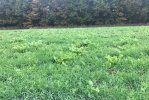This sounds like a great opportunity to write a proposal to get a couple hundred-thousand dollars of grant money to study the question! I think all you can do is consider the most important factors that determine success. How do you define success here? Woo hoo! Another hundred-thousand-dollars of research money to define the problem and present some ideas. Even then, at the end of the day we just say ah, fulsh it, and throw something together hoping for the best.
For what a free thought is worth...
I'd start by understandings the limitations of the area to be planted. There's only so much water and plant food and space available. Then I guess I'd have me a list of the seeds I might consider, the number of seeds (on average) in a pound, and the recommended number of pounds (or, ideally, the number of plants) per acre if planted as a monoculture (a solid planting). If you really want to get down in it, consider the germination rate for each type of plant and you can't do that without knowing what affects germination rates (for each type of plant).
I think solid seeding rates give an idea of the amount of area each type of plant needs. Isn't that the challenge? Not too much, not too little, but just right!
Think about corn. We want something between 22,000 - 28,000 corn stalks per acres (the number keeps drifting around). Soybeans? I don't know. Seems like everyone has a different idea. For kicks and giggles make it 140,000 plants per acre. Rye grain - let's assume (you know what they say about assumptions?) a solid seeding of rye requires 75 lbs of seed germinating at some percentage. To further add to the ass umption let's say there are 18,000 seeds in a pound. So, in a solid seeding we are looking for 1,350,000 plants per acres.
See where this is going? If you have five different plant species you want to throw down in a fixed space and, to make it simple, if you want 20% of your fixed area to contain each of the species your going to need to do some math to figure out the seeding rate so each plant has the potential to get the space it needs.
Or, do you want to fix (keep constant) the number of plants in equal proportions and vary the area planted?
And understand, I'm talking about mixing a bunch of seed together and broadcasting or drilling it all together. How does that affect plant spacing? I dunno. I can't even begin to thank about that dilemma. And then there are the different seasonal requirement, another variable to think about.
Eyes rolling back in you head yet? I don't know about you, but me? On a really good day I might be able to handle three variable at once. Here we have how many? I lost count.
It's not hard math. It's not hard to conceive, but you have to think about what it is you want and I don't know about you but even at my age I'm still not sure.
To end - so, no we don't know the answer - not really.


